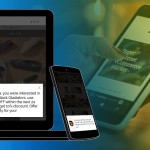I have a friend called Jessica. Oh, I really do.
Just like all of us, she loves to shop online. The only difference is she does that way more than we do. One fine day she made me sit with her to give my suggestions on various kinds of products she had added in her cart—believe me it wasn’t fun—but it did become the genesis of this article. When she opened the particular e-commerce website she had browsed those products on and showed me her cart, I got blown away with the variety and number of products that were added there. Knowing her, my feedback on each item was very quick—either just a yes or a straight forward no. Mostly it was a straight forward no. So, out of the whooping 62 items she had added in her cart, she went ahead and paid for just 6 . . . and thanked me later for helping her saving hard earned bucks.
This got me wondering that even if she just purchased 6 out of 62, she did like most of the products and there is a high chance that she would try to buy those again. Now, that ecommerce store would have made some strategies to target those who add something in their cart but do not purchase, obviously, like most of the other ecommerce stores, but mostly they do that via emails . . . or SMSes . . . or push notifications—those who do have an app version and maintain the seamless transition of user experience across channels and some even do paid ads on Facebook and Twitter.
Now, Web or Browser Push Notifications have been gaining massive popularity and if used by this ecommerce to its full potential, they will convert people like Jessica within a few days and make them buy more and more stuff . . . without spending their fortune. Let’s see all the cases: that ecommerce store, let’s call it ShopMart, decides to target Jessica as she purchased only 10% of the items she added in her cart. ShopMart sends her a promotional email to Jessica, now ShopMart isn’t the only one sending her an email, considering the kind of shopaholic Jessica is, there are thousands of others. There is a high chance she doesn’t even open that email—or she does, in her free time, but at what cost now that the deal is over or the product has gone out of stock! Now, ShopMart decides to send an SMS, except Jessica gets too many promotional SMSes so she has a spam filter in her text messaging app so she misses. Not only did ShopMart spend too much on that SMS but also missed reaching her at the right time. ShopMart, this time, sends a push notification on the mobile app—maybe she did check it out or maybe she didn’t because she had turned them off to avoid getting annoyed all the time. But, ShopMart isn’t the one to get bogged down, it runs a promotional campaign on Facebook for the items she checked out on their webstore. Jessica does, this time, see the ad on time but ends up procrastinating because she is, well, on Facebook and is busy chatting and stalking her friends.
What if ShopMart had web push notifications integrated?
- A push notification could be sent to her even if she wasn’t on the website and wasn’t using the browser too—she would receive them the next time opens the browser
- It’s hard to miss a web push as they pop up on the bottom right of the screen and if controlled the settings, they would stay there until any action is taken
- ShopMart could send a rich, deep linked and relevant push notification to Jessica and make an offer she wouldn’t be able to refuse
- Based on her purchase and browsing history, ShopMart could also recommend products to her
- Based on her activities, ShopMart could include her in relevant segments and launch push campaigns
- ShopMart could also send web push notifications to Jessica on her phone
Not only this, getting started with web push does not affect cash flow in any sense, pricing starts at $0 and integration is painless and quick. Get started here. You could read the ultimate guide to web push notifications here and you may also find out what ShepHertz App42 Platform can do for you in retail. Kill your curiosity and write to us at support@shephertz.com to know more 🙂



















Leave A Reply